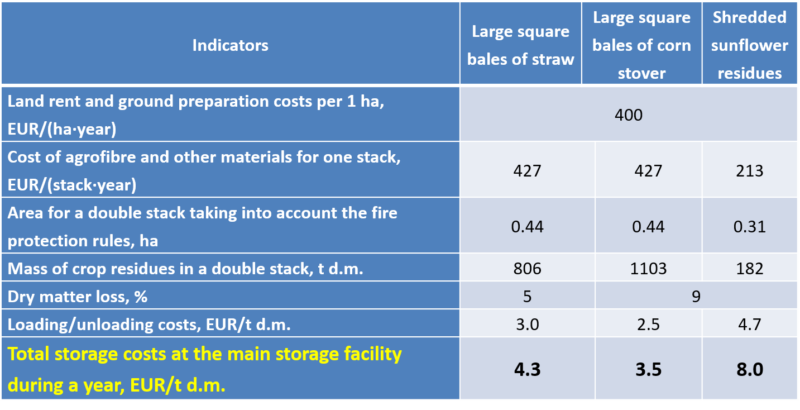Crop residues should be stored under the conditions of keeping its normal amount of moisture against rain and soaking from the ground, avoiding decay and ensuring protection against fire. The selection of a storage type depends on location and local conditions. The biomass can be stored in an open storage, tarped storage, permanent structure storage, or anaerobic storage . Several factors should be considered when selecting appropriate storage systems: feedstock stability during storing, cost of storage infrastructure, accessibility of feedstock during the entire storage duration, integration of the storage with a processing plant.
The storage of biomass in permanent structures offers many advantages in comparison with other systems. However, due to the relatively low density of straw and corn stover, including bales, and high capital costs for a new storage building, the permanent storages are economically unfeasible. In this case, if a stakeholder has permanent storages, he can use them for biomass.
Open-air storage can be used for temporary local storages of the crop residues when the upper layer of biomass serves as coverage. In addition, it can be used as the main storage facility in some regions. However, it is necessary to do it very carefully due to possible losses of dry matter of biomass.
Anaerobic storage or ensiling is a widespread storage method for wet feedstock in the livestock industry. Anaerobic storage remains economically viable for high moisture feedstock, particularly for early season bale storage or emergency storage during extremely wet harvest seasons.
The tarped storage of crop residues offers the optimal balance of cost and quality preservation. Agrofibre material can be used as tarp material, which provides rain and snow protection. It gives a possibility of air out on the surface, which prevents the formation of fungus and mold. The agrofibre is used for wood chip drying. The period of the use of agrofibre is more than 5 years . The straw and corn stover bales and chopped sunflower residues tarped storage with agrofibre was chosen for further cost assessment.
The crop residue storage facilities have to be arranged according to the Fire Safety Regulations in the Agricultural Sector of Ukraine (Order of Ministry of agriculture and Ministry of emergency situation #730/770) . The area of one stack of straw bales must be less than 500 m2, and shredded straw must be less than 300 m2. It is allowed to dispose of bales (chopped straw) in double stacks with a distance not less than 6 m between stacks in pair and not less than 30 m between adjacent double stacks.
It is essential to secure free access to biomass for the loaders. The main cost elements of crop residue tarped storage are land rent costs, ground preparation costs, tarped material, loading/unloading costs, guard costs, and costs associated with feedstock losses due to dry matter loss. The costs assessment of tarped storage for large square bales of straw and corn stover and chopped sunflower residues are given in Table below. The guard costs are not taken into account due to the assumption that the main crop residues storage facility will be placed near the farmer’s storage facility with an existing guard system.
Costs of crop residues storage at the main storage facility

Storage of corn stover in the large square bales under tarp costs 3.5 EUR/ t d.m., which is lower than that for straw (4.3 EUR/t d.m.) and chopped sunflower residues (8.0 EUR/t d.m.).